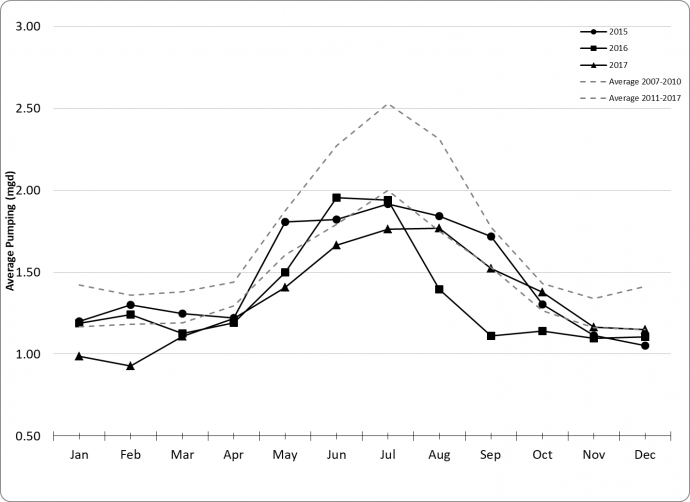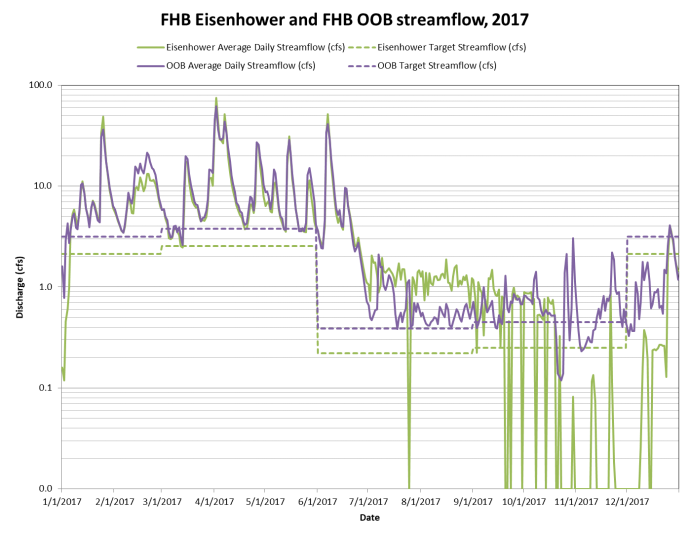
The NSRWA and MassBays have been working with the Town of Scituate since 2007 to find ways to save water and provide flow in the First Herring Brook, while also making sure that the town has water for its residents even during times of drought. The town had major gains in water savings when an irrigation restriction was implemented in 2011 – over 48 million gallons on average in 2011-2017 compared to 2007-2010. The graph shown [right] shows the monthly average pumping in millions of gallons for the two periods mentioned above (pre-restriction 2007-2010 and post-restriction 2011-2017) as well as each month in the past three years. In addition to the savings mentioned previously, the town and its citizens have been doing an impressive job recently of improving their water use over the average. In 2016, conservation netted the town 8 million gallons compared to the average for June-August, and 24 million gallons compared to the average for June-October; much of this was due to the drought. However, it seems as if the conservation mindset has continued in town, because in summer 2017 the town saved 10.5 million gallons compared to the average. The goal for us now is to keep this great progress going.
 Besides having more water available for the needs of the town, these savings also allow the town to provide streamflow in the First Herring Brook. Since 2011 we have been working with Scituate to implement an operational plan that provides a seasonally-appropriate, minimal amount of streamflow year-round. In 2017, the town did an excellent job of meeting these streamflow requirements. It can still be difficult in the fall after summers of more intense water use and less rain. Even though it may seem like summer is over, people do still water through the fall (especially a warm fall like this past one) and it can take months for the system to recover. The graph shown [left] shows the streamflow requirements (straight, dashed lines) as well as the measured streamflow below the Reservoir (Eisenhower Lane) and Old Oaken Bucket pond (zig-zag lines). The measured streamflow is above or at the required amount most of the year. Notice in the fall that streamflow jumps rapidly from high to low (tall vertical lines). This is due to shuttling of water from the Reservoir through the First Herring Brook channel down to Old Oaken Bucket Pond where the water system intake is located. This practice is not ideal because it creates large changes in flow that can cause problems for things living in the stream. We are working with the town to find a compromise between the needs of the habitat and certain operational requirements of the water system itself.
Besides having more water available for the needs of the town, these savings also allow the town to provide streamflow in the First Herring Brook. Since 2011 we have been working with Scituate to implement an operational plan that provides a seasonally-appropriate, minimal amount of streamflow year-round. In 2017, the town did an excellent job of meeting these streamflow requirements. It can still be difficult in the fall after summers of more intense water use and less rain. Even though it may seem like summer is over, people do still water through the fall (especially a warm fall like this past one) and it can take months for the system to recover. The graph shown [left] shows the streamflow requirements (straight, dashed lines) as well as the measured streamflow below the Reservoir (Eisenhower Lane) and Old Oaken Bucket pond (zig-zag lines). The measured streamflow is above or at the required amount most of the year. Notice in the fall that streamflow jumps rapidly from high to low (tall vertical lines). This is due to shuttling of water from the Reservoir through the First Herring Brook channel down to Old Oaken Bucket Pond where the water system intake is located. This practice is not ideal because it creates large changes in flow that can cause problems for things living in the stream. We are working with the town to find a compromise between the needs of the habitat and certain operational requirements of the water system itself.

